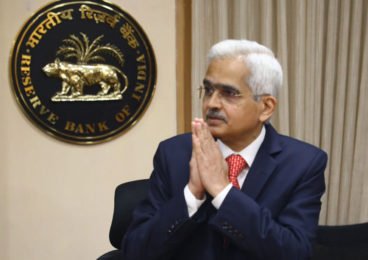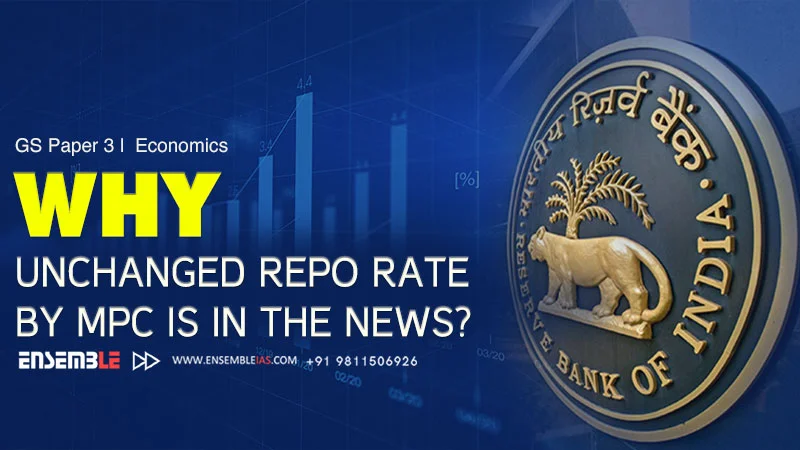Why Unchanged Repo Rate by MPC is in the news?
On Friday, the Reserve Bank of India, Governor Mr. Shaktikanta Das announced that the Monetary Policy Committee (MPC) has unanimously decided to maintain the policy repo rate at 6.50 percent. This decision is after a detailed assessment of the evolving macroeconomic and financial developments and outlook. Mr. Das also explained that the committee aims to keep retail inflation at the targeted rate of 4 percent, which is why they have maintained their withdrawal of accommodation stance. As a result of improved balance sheets for both banks and corporations, the double balance sheet stress that existed ten years ago has been replaced.

The Monetary Policy Committee (MPC) has announced that they will not be changing the benchmark repo rate, which marks the fourth consecutive time it has remained the same. The committee raised the repo rate by 250 basis points previously from May 2020 through April 2023.
The Indian government has directed the Reserve Bank of India (RBI) to keep the Consumer Price Index (CPI) at 4%, with a 2% allowance on either side. The RBI Governor has acknowledged that the decrease in Kharif seeding may pose a threat, but retail inflation is expected to decrease in September. To ensure that retail inflation remains within the target range, which is 4%, the RBI voted 5:1 in Favor of maintaining the current policy.
What is MPC?
The Monetary Policy Committee (MPC) is a committee of six members to reevaluate India’s Economy shape. The Urijit Patel Committee initially recommended a five-person Monetary Policy Committee, but the government proposed a committee of seven members. The Reserve Bank’s Monetary Policy Department (MPD) collaborates with the MPC to formulate policies. The RBI Act of 1934 mandates the establishment of the MPC in India.
The link to join the course : Online Courses
Purpose of MPC
The monetary policy committee aims to maintain price stability and achieve India’s inflation target. The responsibility of developing and implementing India’s monetary policy lies with the Monetary Policy Committee (MPC).
- Price stability
- Accelerating the growth of the economy
- Exchange rate stabilization
- Balancing savings and investment
- Generating employment
- Financial stability
- To control Inflation
Here are a few highlights where MPC is responsible for taking care of it.
Members of MPC
The committee comprises six members: three officials from RBI and three external members nominated by the government, including the Chairman.
- Shaktikant Das
- Michael Debrata Patra
- Rajiv Ranjan
- Ashima Goyal
- Jayanth R. Varma
- Shashanka Bhide
What is REPO?
Repurchase rates, or repo rates, are the interest rates at which a nation’s central bank (such as the Reserve Bank of India, the Federal Reserve in the United States, or the European Central Bank) loans money to commercial banks for a brief period. A “repurchase agreement” or “repo” is the name given to this financial transaction.
Repo Rate Impact Economy
| Cost of Borrowing |
| Inflation Control |
| Exchange Rate Impact |
| Economic expectation |
| Financial Markets |
| Stock market |
| Money Liquidity |
| Loans/EMIs |
| FD/Savings |
| Real Estate |
To summarize, the repo rate plays a crucial role in shaping the Indian economy by impacting borrowing costs, inflation, currency rates, financial markets, and economic growth. The RBI takes into account various economic factors before making any adjustments to the repo rate to maintain price stability and encourage economic growth.
Best Online Coaching for Civil Service_IAS_ UPSC_IFS_IPS
Free Study Material ENSEMBLE IAS ACADEMY | Call +91 98115 06926 | Visit us:- https://ensembleias.com/ | Online Store: https://online.ensemble.net.in/
#reporate #indiane_conomy #ratehikes #MonetaryPolicyCommittee #MPC #Unchanges_reporates #Indian_goveronment #RBI #ReverseRepo #Finance #finance #UPSC #explore #civil_services_study #ensemble_ias_academy #geography_optional #k_siddharthasir #ias #upsc_exam #civilservices #upsc_motivation #upsc_aspirants #trendsingeography




